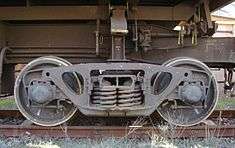List of railroad truck parts

A diagram of an American-style
truck showing the names of its parts
A bogie or railroad truck holds the wheel sets of a rail vehicle.
Axlebox
Also called an axle box, or journal box in North America,[1] an axlebox is the truck or bogie assembly that houses the end of the axle. Early axleboxes contained friction bearings in which the axle spun in a bed of oil. Friction bearings are now illegal in interchange service in the United States; modern axleboxes use roller bearings.[2][3] As early as 1908 they contained a set of long cylindrical rollers allowing the axle to rotate.[4][5] It was also used on steam locomotives such as the Victorian Railways A2 class, the LMS Garratt, the LSWR 415 class, and the GCR Class 1.[4]
Center pin
A large steel pin—or rod—which passes through the center plates on the body bolster and truck bolster.[6] The truck turns about the bolt, and stress is taken by the center plates.[6]
Center plate
One of a pair of plates which fit one into the other and support the car body on the trucks allowing them to turn freely under the car.[6] The one on the truck may also be called center bowl.[7]
Truck side frame
The frame at either side of the truck.[2][3]
Truck bolster
Each truck has a bolster—a transverse floating beam—between the side frames.[8] It is the central part of every truck on which the underframe of the railcar or railroad car is pivoted through the center pivot pin.[6][8]
Image gallery
| Railroad car wheels are affixed to a straight axle, such that both wheels rotate in unison. This is called a wheelset. |
|
See also
References
Further reading



